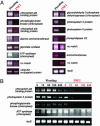Gene expression analysis of plant host-pathogen interactions by SuperSAGE
- PMID: 14676315
- PMCID: PMC307634
- DOI: 10.1073/pnas.2536670100
Gene expression analysis of plant host-pathogen interactions by SuperSAGE
Abstract
The type III restriction endonuclease EcoP15I was used in isolating fragments of 26 bp from defined positions of cDNAs. We call this substantially improved variant to the conventional serial analysis of gene expression (SAGE) procedure "SuperSAGE." By applying SuperSAGE to Magnaporthe grisea (blast)-infected rice leaves, gene expression profiles of both the rice host and blast fungus were simultaneously monitored by making use of the fully sequenced genomes of both organisms, revealing that the hydrophobin gene is the most actively transcribed M. grisea gene in blast-infected rice leaves. Moreover, SuperSAGE was applied to study gene expression changes before the so-called hypersensitive response in INF1 elicitor-treated Nicotiana benthamiana, a "nonmodel" organism for which no DNA database is available. Again, SuperSAGE allowed rapid identification of genes up- or down-regulated by the elicitor. Surprisingly, many of the down-regulated genes coded for proteins involved in photosynthesis. SuperSAGE will be especially useful for transcriptome profiling of two or more interacting organisms like hosts and pathogens, and of organisms, for which no DNA database is available.
Figures




Similar articles
-
SuperSAGE: powerful serial analysis of gene expression.Methods Mol Biol. 2012;883:1-17. doi: 10.1007/978-1-61779-839-9_1. Methods Mol Biol. 2012. PMID: 22589121
-
[Identification of genes related to resistance to Magnaporthe grisea using differential display technique in rice].Yi Chuan Xue Bao. 2005 Jul;32(7):719-25. Yi Chuan Xue Bao. 2005. PMID: 16078740 Chinese.
-
OsNAC111, a blast disease-responsive transcription factor in rice, positively regulates the expression of defense-related genes.Mol Plant Microbe Interact. 2014 Oct;27(10):1027-34. doi: 10.1094/MPMI-03-14-0065-R. Mol Plant Microbe Interact. 2014. PMID: 25014590
-
SuperSAGE.Cell Microbiol. 2005 Jan;7(1):11-8. doi: 10.1111/j.1462-5822.2004.00478.x. Cell Microbiol. 2005. PMID: 15617519 Review.
-
SuperSAGE: a modern platform for genome-wide quantitative transcript profiling.Curr Pharm Biotechnol. 2008 Oct;9(5):368-74. doi: 10.2174/138920108785915157. Curr Pharm Biotechnol. 2008. PMID: 18855689 Review.
Cited by
-
Eclair--a web service for unravelling species origin of sequences sampled from mixed host interfaces.Nucleic Acids Res. 2005 Jul 1;33(Web Server issue):W724-7. doi: 10.1093/nar/gki434. Nucleic Acids Res. 2005. PMID: 15980572 Free PMC article.
-
Serial analysis of gene expression study of a hybrid rice strain (LYP9) and its parental cultivars.Plant Physiol. 2005 Jul;138(3):1216-31. doi: 10.1104/pp.105.060988. Plant Physiol. 2005. PMID: 16009997 Free PMC article.
-
Serial analysis of gene expression in sugarcane (Saccharum spp.) leaves revealed alternative C4 metabolism and putative antisense transcripts.Plant Mol Biol. 2007 Apr;63(6):745-62. doi: 10.1007/s11103-006-9121-z. Epub 2007 Jan 9. Plant Mol Biol. 2007. PMID: 17211512
-
SuperSAGE: the drought stress-responsive transcriptome of chickpea roots.BMC Genomics. 2008 Nov 24;9:553. doi: 10.1186/1471-2164-9-553. BMC Genomics. 2008. PMID: 19025623 Free PMC article.
-
Large-scale gene disruption in Magnaporthe oryzae identifies MC69, a secreted protein required for infection by monocot and dicot fungal pathogens.PLoS Pathog. 2012;8(5):e1002711. doi: 10.1371/journal.ppat.1002711. Epub 2012 May 10. PLoS Pathog. 2012. PMID: 22589729 Free PMC article.
References
-
- Velculescu, V. E., Zhang, L., Vogelstein, B. & Kinzler, K. W. (1995) Science 270, 484–487. - PubMed
-
- Matsumura, H., Nirasawa, S., Kiba, A., Urasaki, N., Saitoh, H., Ito, M., Kawai-Yamada, M., Uchimiya, H. & Terauchi, R. (2003) Plant J. 33, 425–434. - PubMed
-
- Irie, T., Matsumura, H., Terauchi, R. & Saitoh, H. (2003) Mol. Gen. Genet. 270, 181–189. - PubMed
-
- Janscak, P., Sandmeier, U., Szczelkun, M. D. & Bickle, T. A. (2001) J. Mol. Biol. 306, 417–431. - PubMed
Publication types
MeSH terms
Substances
LinkOut - more resources
Full Text Sources
Other Literature Sources
Research Materials
Miscellaneous

